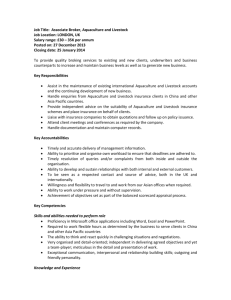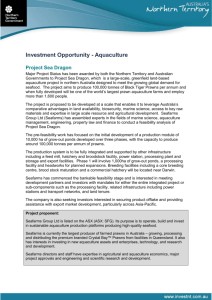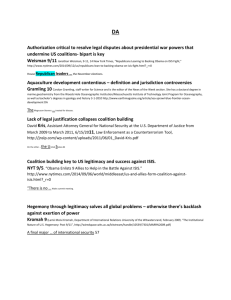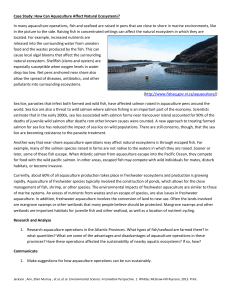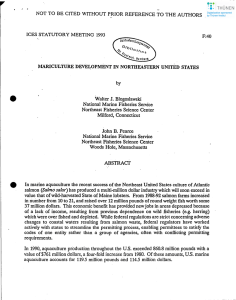AquacultureGrowers
advertisement
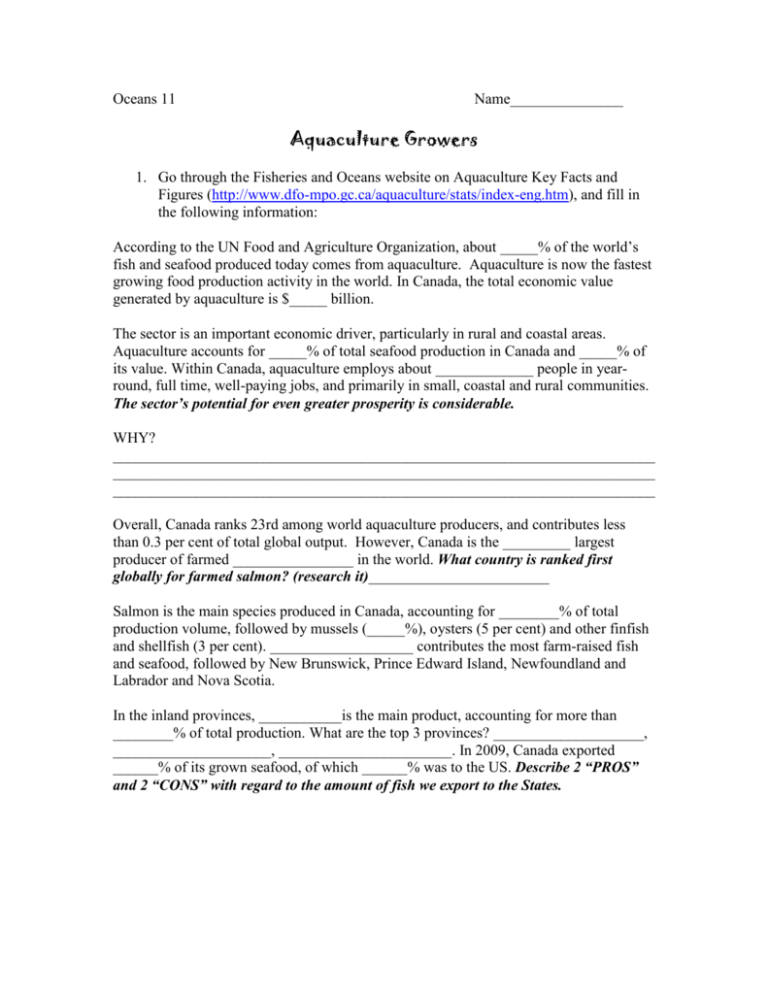
Oceans 11 Name_______________ Aquaculture Growers 1. Go through the Fisheries and Oceans website on Aquaculture Key Facts and Figures (http://www.dfo-mpo.gc.ca/aquaculture/stats/index-eng.htm), and fill in the following information: According to the UN Food and Agriculture Organization, about _____% of the world’s fish and seafood produced today comes from aquaculture. Aquaculture is now the fastest growing food production activity in the world. In Canada, the total economic value generated by aquaculture is $_____ billion. The sector is an important economic driver, particularly in rural and coastal areas. Aquaculture accounts for _____% of total seafood production in Canada and _____% of its value. Within Canada, aquaculture employs about _____________ people in yearround, full time, well-paying jobs, and primarily in small, coastal and rural communities. The sector’s potential for even greater prosperity is considerable. WHY? ________________________________________________________________________ ________________________________________________________________________ ________________________________________________________________________ Overall, Canada ranks 23rd among world aquaculture producers, and contributes less than 0.3 per cent of total global output. However, Canada is the _________ largest producer of farmed ________________ in the world. What country is ranked first globally for farmed salmon? (research it)________________________ Salmon is the main species produced in Canada, accounting for ________% of total production volume, followed by mussels (_____%), oysters (5 per cent) and other finfish and shellfish (3 per cent). ___________________ contributes the most farm-raised fish and seafood, followed by New Brunswick, Prince Edward Island, Newfoundland and Labrador and Nova Scotia. In the inland provinces, ___________is the main product, accounting for more than ________% of total production. What are the top 3 provinces? ____________________, _____________________, _______________________. In 2009, Canada exported ______% of its grown seafood, of which ______% was to the US. Describe 2 “PROS” and 2 “CONS” with regard to the amount of fish we export to the States. 2. Go to Frequently Asked Questions http://www.dfo-mpo.gc.ca/aquaculture/faqeng.htm#n1o and scroll down to answer the following: A) What is the size of a fish farm or shellfish farm operation? Give details. B) How many salmon are grown at one time? C) What is the age, size and weight of the average farmed fish at harvest? D) How many mussels can be grown at one time? *Which type of organism would be easier and more economical to farm – finfish or shellfish? Why? E) What is the age and size of cultured mussels at harvest? F) What is the age and size of cultured Pacific oysters at harvest? G) Why are Atlantic salmon farmed in BC? 3. Consider the following graphs and information and respond to the questions: A) What could be 2 possible reasons for BC to have over 50% of the total output of aquaculture products, compared to the Maritimes? B) What are two possible reasons to explain why salmon represents such a large % of total output? C) Is this trend of aquaculture production sustainable? Explain why or why not. Aquaculture Production in Canada (1990-2009) - Canadian production has increased four-fold in the past 20 years D) Consider the economic impact of aquaculture from province to province. Economic NL Indicator GDP ($000s) Direct 20,000 Indirect 8,400 Induced 6,200 Total 34,600 Employment (FTE) Direct 215 Indirect 120 Induced 70 Total 405 Income ($000s) Direct 6,200 Indirect 4,900 Induced 2,200 Total 13,300 NS PEI NB QC ON BC Canada 22,800 10,600 8,500 41,900 42,800 6,400 10,400 59,600 69,100 47,200 30,800 147,100 8,200 2,500 3,700 14,400 7,480 4,080 4,250 15,810 151,100 167,900 106,300 425,300 321,480 450,400 233,300 1,005,180 380 170 120 670 790 125 250 1,165 1,100 790 530 2,420 80 35 45 160 110 55 51 216 2,220 2,330 1,410 5,960 4,895 6,400 3,200 14,495 12,200 6,400 4,800 23,400 22,000 2,900 6,400 31,300 32,700 28,300 16,800 77,800 2,600 1,200 1,230 5,030 2,720 2,040 1,530 6,290 78,400 95,100 50,400 223,900 156,820 241,200 107,900 505,920 A) Give three examples of DIRECT employment opportunities. ___________________________________________________________ ___________________________________________________________ ___________________________________________________________ B) Give three examples of INDIRECT employment opportunities. ___________________________________________________________ ___________________________________________________________ ___________________________________________________________ C) What would be “induced” economic indicators? Give two examples. ___________________________________________________________ ___________________________________________________________ D) Which province has: The greatest difference between direct and indirect income ($000s)? ___________________ Suggested explanation?____________________ __________________________________________________________ An almost equal balance between direct and indirect income? ___________________ Suggested explanation?____________________ __________________________________________________________ More indirect income than direct income? ___________________ Suggested explanation?____________________ __________________________________________________________ More induced income than direct income? ___________________ Suggested explanation?____________________ __________________________________________________________


